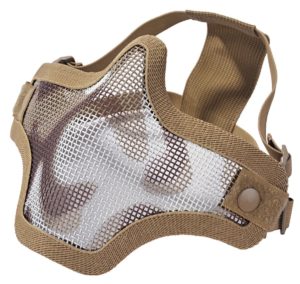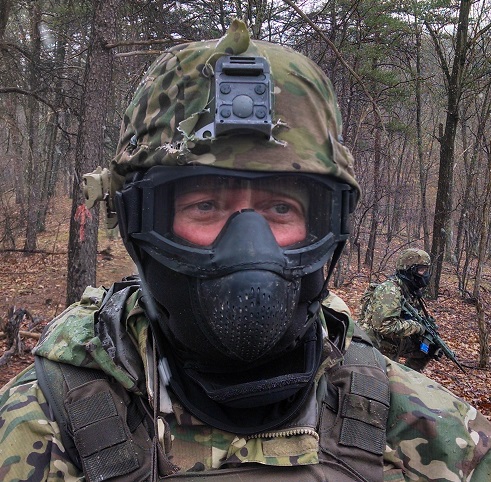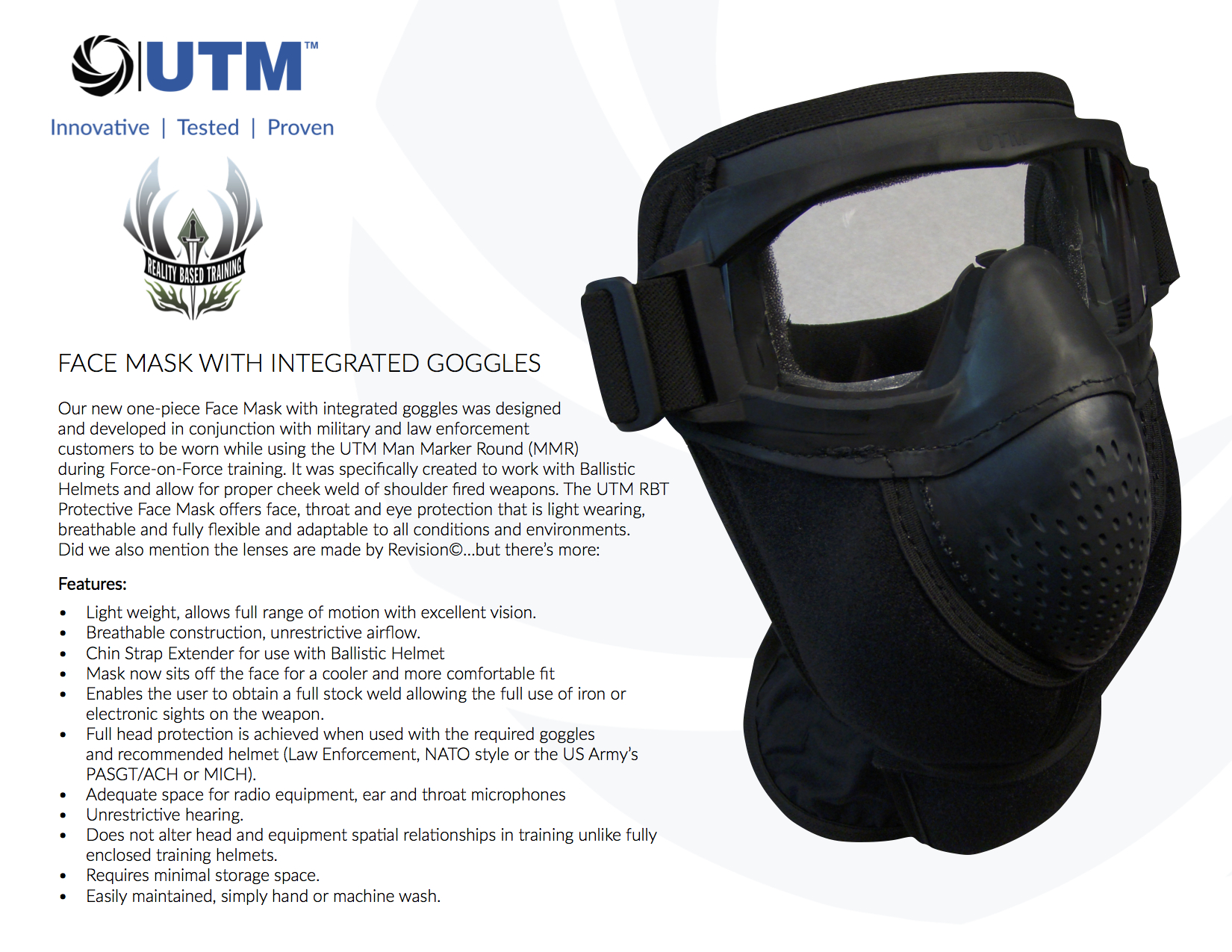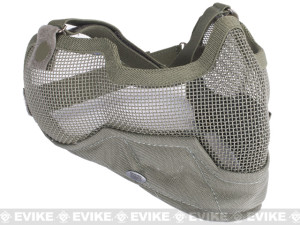Guidance on UTM Force on Force / CQB Personal Protective Equipment (PPE)
Force on Force Personal Protective Equipment (PPE):
Personal Protection Equipment for UTM Force on Force Training:
The minimum of protection is as follows:
- Ballistic Eye Protection (Sealed).
- No Exposed Skin.
Optional, recommended by UTM:
- Loose clothing:
- An outer layer of BDU style clothing is recommended.
- 2 layers of loose clothing is recommend by UTM.
- Military style helmet, either ballistic or bump, solid with no gaps / holes.
- Groin protector/cup ‘recommended.’
- Tactical / ballistic gloves.
- Females: chest protector.
- Body armor / plates / chest rig / tactical vest or similar to cover the chest area.
Detailed Guidance Points:
In addition to what is listed above, we have the following detailed guidance:
- The basic bottom-line PPE for UTM Force on Force is:
- No exposed Skin
- Ballistic Eye Protection, sealed without gaps.
- Plus: No contact shots (less than 1 meter from muzzle)
- We use Reduced Velocity Man Marker Rounds (RVR) @270 fps for CQB-specific classes.
- We use the standard Man Marker Rounds (MMR) @370 fps for Force on Force Team Tactics and the Combat Leader Course.
- Where the MMR are used, there is still CQB, in buildings and outside, and the potential for closer shots outside of contact shot range.
- The purpose of the RVR is that during the CQBC, all contact is at close range, and thus we do not need the range / accuracy to fight out to the maximum range of MMR, which is 50 meters.
- Whether RVR or MMR, all of this is safe at close ranges, if correct PPE is worn.
Gloves: Wear protective gloves with either plastic or leather-type protection. Hands get hit a lot during CQB. Examples of decent protective gloves:
Mechanix standard M-Pact:
Mechanix M-Pact 3:
Ballistic Eye Protection: You must wear a ballistic goggle that leaves no gaps / is sealed to your face, with an appropriate goggle strap. Appropriate goggles include military issue / approved (APEL) certified to ANSI Z87+ impact protection / military APEL equivalent. Also, appropriate quality ‘thermal’ (double layer) paintball mask/goggle combinations that meet or exceed ANSI Z87+ / ASTM F1776 (the paintball safety standard). You cannot take any risks with your vision, so make sure your eye protection is adequate. Simple wrap-around shades do not suffice. ‘Thermal’ double layer goggles also provide a solution to fogging.
Eye/Face Protection:
We do offer the standard issue military UTM facial protection. You can ask for this at class if you wish. Students have reported finding it hard to breath through the air holes when conducting active SUT in the woods. The purpose of allowing students to bring their own PPE, is to enhance comfort and thus effectiveness and learning during class. However, safety cannot be compromised, and if in doubt these masks do work very well. If you are concerned with effective close range CQB PPE, this mask would work for you due to less ‘running around’ in CQB, compared to climbing the hills in Force on Force Team Tactics.
The goggles on the UTM mask are certified ANSI Z87.1-2010 Standard. The lenses are ‘off the shelf’ military Revision Desert Locust. The key advantage of these masks is the lack of any gaps / a proper seal around the goggles created by the neoprene-style mask.
This is what the UTM-issue mask looks like:
If you are doing FoF in the woods, a simple combo of a face gator / neoprene type mask, neck protector, with hat and ballistic googles will work. You must ensure that there are no gaps around the sides of your goggles which may permit a UTM round to enter.
If you want additional hard facial protection, which is recommended for CQB classes, you can wear an additional mesh mask over top of your face coverage, or a mask on its own if it provides sufficient coverage and no exposed skin. Note that these often need to be bent and shaped to fit your face, they likely will not fit right out of the box, which surprises people when they get them out first time at class! Mesh shields as shown below are sold at EVIKE.COM HERE.
Full face / ear protection:
Limited front face protection (needs to be used along with with a gator type face covering):

If you wear the smaller mesh mask, shown above with no ear coverage, then this should be seen as additional hard protection over the top of a gator or neoprene mask that covers the rest of the exposed skin.
However, you need to ensure that if you are wearing a goggle / mesh mask / helmet combo, that the goggles are not sat up with their bottom part on top of the mesh mask, and there are no gaps around the goggles, or up in the ear / temple area of the helmet. You must have goggles that are sitting flush on your face, and no exposed skin. You must take the time before class to ensure that your mesh mask fits with your goggles. Problems are caused by students showing up with poor or unfitted equipment which they have not taken the time to practise fitting prior to class. If your equipment is inadequate or does not work as described, you will be issued a UTM mask for the class.
In the photo below is an example using lower profile Smith Optics Elite Boogie Sport Tactical Goggles. These have been fitted with the full face / ear Evike mask shown above, and a helmet. The goggles sit nicely below the mesh mask, and there are no gaps:
This is a student wearing a helmet / mesh mask / goggle combo:
You can wear a combination paintball helmet / mask along with some form of neck protector. This is easy to take on and off and avoids the need to try and make all the elements work together. It has the advantage of there being a seal around the googles created by the hard mask. If you purchase something like this, ensure that the goggles are rated to or beyond ASTM F1776 . Also ensure any holes on the mask are smaller than .223, the size of the UTM round. The JT Spectra is advertised as:
The Spectra lens offers over an 1/8 inch thick of poly carbonite for solid impact protection. The Spectra design has been tested at 5x field energy levels for your safety to exceed every industry standard across the board. Additionally, each thermal lens offers 260 degree of optically clear peripheral vision, as well as proven T-lock retention system to keep your lens in place at all times. All Spectra lens meet ASTM standards.
Shown below is a JT Spectra Flex 8 Full Head and Face Coverage Thermal Paintball Goggle, in use by Max. It offers full face, eye and head protection, and is thus easy to fit on and off:
The key to all of this is to ensure that you have a seal around the eyes with the goggles, and that the rest of your face / head protection fits together with your goggles, so that there are no gaps. With a paintball helmet, getting the one shown above means that you do not have to try and fit it together with a helmet / hat, which is hard to do with a face-only paintball mask. For ease of use and full face / head protection, a full paintball helmet works very well.
It is your responsibility to ensure that any product that you bring to class meets the protection / ballistic rating / standards as laid out above.
If you want to be truly dangerous to your enemies, train at MVT.
General Info / Links:









